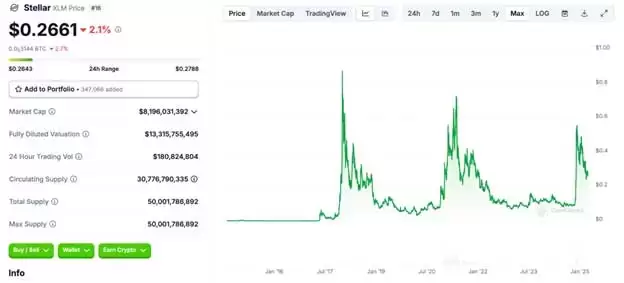 |
|
 |
|
 |
|
 |
|
 |
|
 |
|
 |
|
 |
|
 |
|
 |
|
 |
|
 |
|
 |
|
 |
|
 |
|
Cryptocurrency News Articles
From Memes to Real-World Performance: How BlockDAG is Building Sustainable Value in a Volatile Market
Mar 31, 2025 at 12:00 am
While meme coins like Pepe and Official Trump have drawn headlines with rapid gains and steep drops, BlockDAG is quietly building under real-world conditions.

In the fast-moving world of crypto, hype moves swiftly but real performance needs proof. While meme coins like Pepe and Official Trump have grabbed headlines with rapid gains and steep drops, BlockDAG is quietly building and testing its network.
The Primordial Beta Testnet Is Pivotal in a Pivotal Year
Pepe has seen massive early returns driven by social buzz, and $TRUMP surged on political timing—only to face volatility and sustainability questions.
In contrast, BlockDAG is simulating economic traffic, miner load, and user activity to validate its network at scale. With over $209.5 million raised and 19 billion coins sold, it’s showing what long-term resilience looks like in a space often dominated by short-term speculation.
Pepe Coin: From Meme to Millions
Launched in 2023 as a meme-based cryptocurrency inspired by the popular Pepe the Frog meme, Pepe Coin (PEPE) has become one of the most talked-about and, for early backers, lucrative meme tokens on the market. Initially fueled by social media hype and community engagement, which saw the coin gain attention on platforms such as X (formerly Twitter) and Telegram, PEPE has delivered substantial returns to its supporters.
Having surged over 300% since its initial coin offering, the coin is currently trading at $0.00001226. Furthermore, with predictions of a 450% to 1500% increase in 2025 alone and an average return of 276%, and considering that some analysts suggest a potential return of 19,000% on an initial investment of $500 in early 2024, which would amount to approximately $4,000 at present, it's no surprise that interest in the token continues to grow.
Moreover, the coin's structure and tokenomics are also factors in its performance. Specifically, its deflationary tokenomics, which sees a portion of each transaction burned, has contributed to the appreciation of the coin's value.
However, despite its popularity, the coin has also faced criticism for lack of fundamentals and its role in investor losses.
Official Trump Coin: Political Clout Sparks Huge Gains
The $TRUMP meme coin, launched on January 17, 2025, just days before Donald Trump's second presidential inauguration, quickly became one of the most talked-about digital assets in recent times.
Within only 48 hours, its market cap soared from $600 million to over $13 billion, and its price skyrocketed from $7 to a peak of $75 per token—an increase of over 900%. As a result, early investors saw returns ranging from 300% to 19,000%, with some turning modest investments into multi-million-dollar gains.
Yet, the coin's performance has since faltered. As of late March 2025, its value has dropped by more than 50% from its peak, now trading between $12.50 and $14. Still, long-term forecasts remain optimistic, with analysts predicting a 289% increase by the end of 2025, potentially reaching €62.97.
At the same time, the Trump Organization retains ownership of 80% of the token supply, which has sparked concerns over centralization and potential conflicts of interest.
Meanwhile, while the coin has generated over $350 million in revenue from token sales and fees, it has also drawn criticism for ethical concerns and investor losses.
Ultimately, the $TRUMP coin embodies both the explosive potential and inherent risks of politically branded cryptocurrencies in an era of political fluidity and heightened partisanship.
BlockDAG Beta Testnet Is Pivotal in a Pivotal Year
In an industry often focused on short-term hype, BlockDAG is taking a different approach. Its Primordial Beta Testnet isn’t a simple demo—it’s a true-to-life proving ground.
From the outset, the Primordial Testnet has been engineered to simulate the conditions the mainnet will face. This includes testing transaction speeds, miner participation, and wallet behavior.
The testnet isn’t just about identifying bugs—it’s about measuring how the network holds up when subjected to real-world pressure.
To achieve this, the testnet supports over 2,000 transactions per second using a DAG-based Proof-of-Work consensus (GHOSTDAG) that processes blocks in parallel, giving it a structural advantage over traditional blockchains.
Considering this, it’s no surprise that over 200 mining nodes and tens of thousands of wallets are expected to participate in the network. The system is already validating high-volume
Disclaimer:info@kdj.com
The information provided is not trading advice. kdj.com does not assume any responsibility for any investments made based on the information provided in this article. Cryptocurrencies are highly volatile and it is highly recommended that you invest with caution after thorough research!
If you believe that the content used on this website infringes your copyright, please contact us immediately (info@kdj.com) and we will delete it promptly.





























































